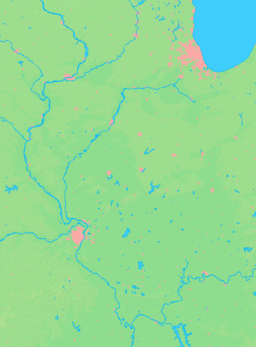Pana, Illinois
| Pana | |
| City | |
| Nickname: City of Roses | |
| Country | United States |
|---|---|
| State | Illinois |
| County | Christian |
| Elevation | 698 ft (213 m) |
| Coordinates | 39°23.2′N 89°4.9′W / 39.3867°N 89.0817°WCoordinates: 39°23.2′N 89°4.9′W / 39.3867°N 89.0817°W |
| Area | 4.15 sq mi (11 km2) |
| - land | 3.84 sq mi (10 km2) |
| - water | 0.31 sq mi (1 km2) |
| Population | 5,847 (2010) |
| Density | 2,101.7/sq mi (811/km2) |
| Mayor | Steve Sipes |
| Timezone | CST (UTC−6) |
| - summer (DST) | CDT (UTC−5) |
| Postal code | 62557 |
| Area code | 217 |
  Location of Pana within Illinois | |
| Wikimedia Commons: Pana, Illinois | |
Pana /ˈpeɪnə/ is a city in Christian County, Illinois, United States. The population was 5,614 at the 2000 census.
Geography
Pana is located at 39°23.2′N 89°4.9′W / 39.3867°N 89.0817°W (39.3871, -89.0812).[1]
According to the 2010 census, Pana has a total area of 4.148 square miles (10.74 km2), of which 3.84 square miles (9.95 km2) (or 92.57%) is land and 0.308 square miles (0.80 km2) (or 7.43%) is water.[2]
History
Pana was first known as Stone Coal Precinct when it was founded on June 6, 1845. The name was later changed to Pana Township on September 2, 1856. In 1857, the village of Pana was incorporated. It was at the intersection of east-west and north-south railroads, and had supplies of fuel and water for the steam engines of the railroad.
The name "Pana" is derived from the American Indian tribe, the Pawnee.
Pana came to be known as the City of Roses, coined by local newsmen, the Jordan Brothers. Many major florists and growers set up shop here. At one time, there were 109 greenhouses in Pana.
Kitchell Park, one of the few parks listed in the United States National Register of Historic Places, is located in Pana and was added to the Register in 1992.
Events
Pana Heritage Days
- The Pana Heritage Days are an annual festival that takes place during the last weekend in May. Streets are blocked off and are filled with multiple vendors and fair rides. Live band music is generally provided.
Labor Day Parade
- The Pana Labor Day Parade is held annually on labor day, and is attended by up to 15,000 people, the largest in all of Illinois. The 2011 parade featured 343 firemen marching to lead the parade in an honor to the firemen, paramedics, and policemen who died on the terrorist attacks on September 11, 2001.
Tri-County Fair
- The Tri-County Fair is held annually and lasts for six days. The fair begins on the Wednesday before Labor Day and ends on Labor Day. It features many carnival rides, vendors, and games. Average attendance per day is 7,000 persons.
Notable people
- Nin Alexander (1858–1933), player for the Kansas City Unions and the St. Louis Browns, born in Pana (1858).[3]
- Warren Amling (1924–2001), a football and basketball player, played for Ohio State, a 1984 College Football Hall of Fame inductee, born in Pana (1924)
- Howard Graham Buffett (1954-), author, activist and philanthropist, owns a farm in rural Pana
- Thomas Henry Carter (1854–1911), senator, grew up in Pana
- Ed Coady (c. 1867-), quarterback for the Notre Dame, born in Pana (1867)
- Pat Coady (1867–1943), quarterback for the Notre Dame, born in Pana (1867)
- Mike Cvengros (1900–1974), pitcher with the New York Giants, the Pittsburgh Pirates, the Chicago White Sox, and the Chicago Cubs, born in Pana (1900)
- John Wesley Fribley (1906–2002), state senate (1934–1952)[4]
- Garet Garrett (1878–1954), notable 20th-century econo-political commentator and author
- Hector Honore (1905–1983), race car driver and owner, died in Pana and was inducted into the National Sprint Car Hall of Fame & Museum in 1991
- Jeff Keener (b. 1959), pitcher for the St. Louis Cardinals
- Dick Klein (b. 1934), All-Star offensive lineman for the Chicago Bears, the Dallas Cowboys, the Boston Patriots, and the Oakland Raiders, born in Pana (1934)
- Albert Marsh (1877–1944), inventor of chromel, born in Pana (1877)
- Vincent Sheean (1899–1975), war correspondent and author of the book Personal History, born in Pana on December 5, 1899[5]
- Herb Siegert (1924–2008), former guard for the Washington Redskins, born in Pana (1924)
Demographics
| Historical population | |||
|---|---|---|---|
| Census | Pop. | %± | |
| 1870 | 2,207 | — | |
| 1880 | 3,009 | 36.3% | |
| 1890 | 5,077 | 68.7% | |
| 1900 | 5,530 | 8.9% | |
| 1910 | 6,055 | 9.5% | |
| 1920 | 6,122 | 1.1% | |
| 1930 | 5,835 | −4.7% | |
| 1940 | 5,966 | 2.2% | |
| 1950 | 6,178 | 3.6% | |
| 1960 | 6,432 | 4.1% | |
| 1970 | 6,326 | −1.6% | |
| 1980 | 6,040 | −4.5% | |
| 1990 | 5,796 | −4.0% | |
| 2000 | 5,614 | −3.1% | |
| 2010 | 5,847 | 4.2% | |
| Est. 2015 | 5,607 | [6] | −4.1% |
As of the census[8] of 2000, there were 5,614 people, 2,317 households, and 1,443 families residing in the city. The population density was 2,101.7 people per square mile (811.8/km²). There were 2,532 housing units at an average density of 947.9 per square mile (366.1/km²). The racial makeup of the city was 99.09% White, 0.07% African American, 0.14% Native American, 0.25% Asian, 0.05% from other races, and 0.39% from two or more races. Hispanic or Latino of any race were 0.50% of the population.
There were 2,317 households out of which 28.6% had children under the age of 18 living with them, 47.2% were married couples living together, 11.5% had a female householder with no husband present, and 37.7% were non-families. 34.7% of all households were made up of individuals living alone and 19.6% of those individuals were 65 years of age or older. The average household size was 2.32 and the average family size was 2.97.
In the city the population was spread out with 24.5% under the age of 18, 7.7% from 18 to 24, 24.6% from 25 to 44, 21.0% from 45 to 64, and 22.2% who were 65 years of age or older. The median age was 40 years. For every 100 females there were 86.1 males. For every 100 females age 18 and over, there were 80.6 males.
The median income for a household in the city was $29,611, and the median income for a family was $35,406. Males had a median income of $30,519 versus $18,675 for females. The per capita income for the city was $14,897. About 11.5% of families and 17.6% of the population were below the poverty line, including 28.7% of those under age 18 and 18.8% of those age 65 or over.
References
- ↑ "US Gazetteer files: 2010, 2000, and 1990". United States Census Bureau. 2011-02-12. Retrieved 2011-04-23.
- ↑ "G001 - Geographic Identifiers - 2010 Census Summary File 1". United States Census Bureau. Retrieved 2015-12-27.
- ↑ "Nin Alexander". Baseball-Reference.Com. Retrieved September 22, 2012.
- ↑ http://library.uis.edu/archives/collections/oral/oralf.html#F911
- ↑ Vincent Sheean
- ↑ "Annual Estimates of the Resident Population for Incorporated Places: April 1, 2010 to July 1, 2015". Retrieved July 2, 2016.
- ↑ "Census of Population and Housing". Census.gov. Retrieved June 4, 2015.
- ↑ "American FactFinder". United States Census Bureau. Retrieved 2008-01-31.
External links
| Wikisource has the text of the 1911 Encyclopædia Britannica article Pana. |